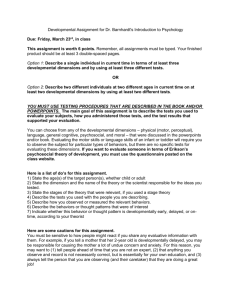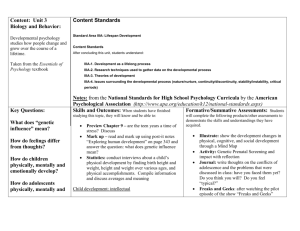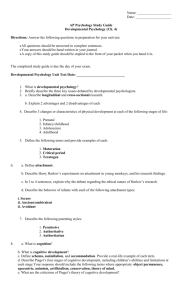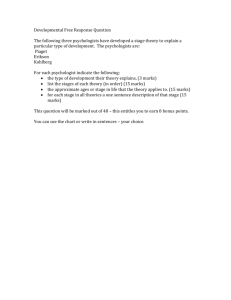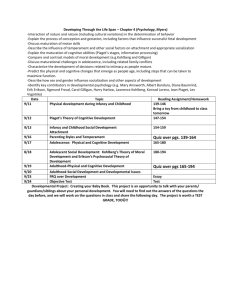II. Later years
advertisement
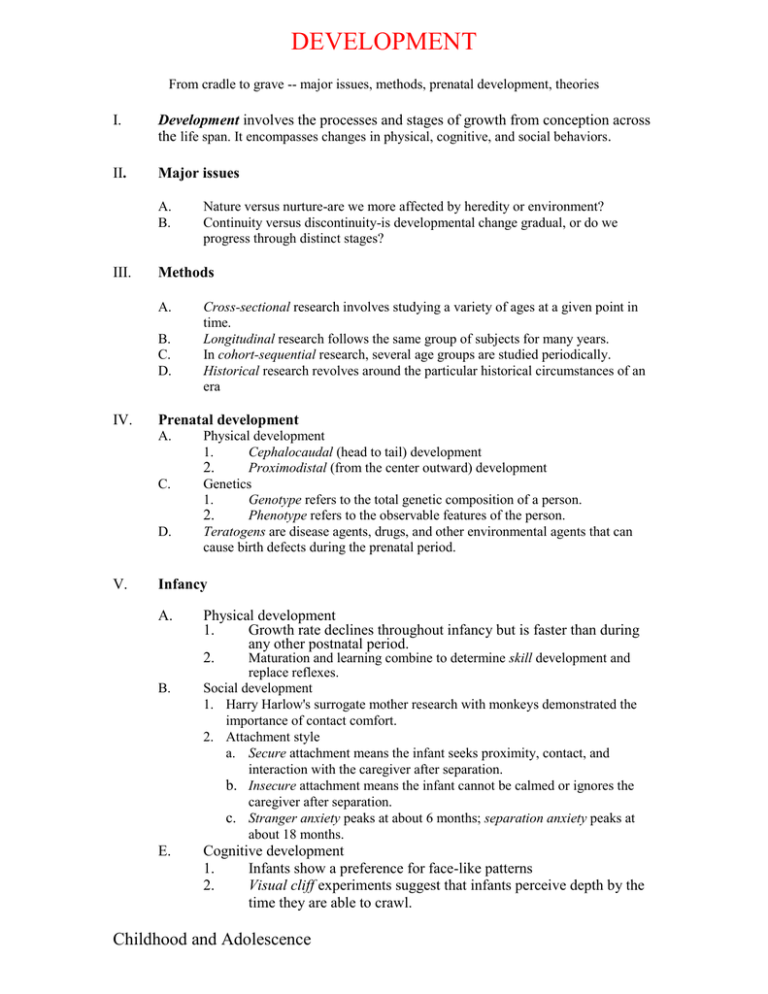
DEVELOPMENT From cradle to grave -- major issues, methods, prenatal development, theories I. Development involves the processes and stages of growth from conception across the life span. It encompasses changes in physical, cognitive, and social behaviors. II. Major issues A. B. III. Methods A. B. C. D. IV. Cross-sectional research involves studying a variety of ages at a given point in time. Longitudinal research follows the same group of subjects for many years. In cohort-sequential research, several age groups are studied periodically. Historical research revolves around the particular historical circumstances of an era Prenatal development A. C. D. V. Nature versus nurture-are we more affected by heredity or environment? Continuity versus discontinuity-is developmental change gradual, or do we progress through distinct stages? Physical development 1. Cephalocaudal (head to tail) development 2. Proximodistal (from the center outward) development Genetics 1. Genotype refers to the total genetic composition of a person. 2. Phenotype refers to the observable features of the person. Teratogens are disease agents, drugs, and other environmental agents that can cause birth defects during the prenatal period. Infancy A. B. E. Physical development 1. Growth rate declines throughout infancy but is faster than during any other postnatal period. 2. Maturation and learning combine to determine skill development and replace reflexes. Social development 1. Harry Harlow's surrogate mother research with monkeys demonstrated the importance of contact comfort. 2. Attachment style a. Secure attachment means the infant seeks proximity, contact, and interaction with the caregiver after separation. b. Insecure attachment means the infant cannot be calmed or ignores the caregiver after separation. c. Stranger anxiety peaks at about 6 months; separation anxiety peaks at about 18 months. Cognitive development 1. Infants show a preference for face-like patterns 2. Visual cliff experiments suggest that infants perceive depth by the time they are able to crawl. Childhood and Adolescence I. Childhood A. Physical development 1. more extensive neural networks continue to develop in the brain 2. Growth rate continues to decline B. Social development 1. Interaction with the environment provides a sense of gender identity. 2. A greater sense of independence develops as peer relationships begin to become more important. C. Cognitive development continues at a rapid rate. There are advances in the areas of 1. Leaming 2. Language 3. Thinking skills II. Adolescence A. Physical/ sexual development-puberty B. Social development 1. Peer groups take on an increasingly important role. 2. Opposite-sex relationships gradually become less recreational and more intimate C. Cognitive development 1. Capability for logical, hypothetical, and introspective thinking develops 2. Growing awarenesss of one's own mental processes developsmetacognition Adolescent development relates to many important societal problems, such as suicide, teen pregnancy, and eating disorders. III. Adult and later years I. Adulthood A. Physical changes 1. Abilities peak and begin a gradual (1% a year) decline. 2. Women undergo menopause, with its hormonal and reproductive changes. B. Social changes center around such issues as: 1. Mate selection 2. Parenting 3. Career selection C. Cognitive changes vary significantly with some people showing declines and others not. 1. Reaction time appears to decline. 2. Some adults show a decline in memory. II. Later years A. Physical changes 1. There is a general decline in muscle tone and sensory abilities 2.Senile dementia and Alzheimer's disease are two disorders that may develop. B. Social issues include: 1. Retirement 2. Social isolation, which may be caused by loss of spouse and others, lack of mobility and declining health C. Cognitive declines are likely to continue. Piaget’s Theory of Cognitive Development A. Sensorimotor stage, birth to 18 months 1. Characteristics a. Cognitive structures or schema are the means by which humans acquire and apply knowledge about their world. b. Assimilation is the use of available cognitive structures to gain new information. c. Accommodation is the process of modifying cognitive structures in the face of newly realized complexities in the environment. Developmental achievements a. Circular reactions are repetitive motions babies engage in as they gradually learn to explore their environment nonreflexively. b. object permanence is the understanding that objects continue to exist even when --hidden from view. 2. B. Preoperational stage, 18 months to 6 years 1. Characteristics a. Egocentrism is a limited ability to comprehend a situation from a perspective one has not experienced. b. Animism is the tendency to attribute life to inanimate things. c. Artificialism is the tendency to believe everything is the product of human action. Developmental achievements a. Symbolic representation and language b. Readiness for operational thought 2. C. Concrete-operational stage, 6 years to early adolescence 1. Characteristics a. 2. a. b. c. D. Conservation is the principle that matter does not increase or decrease because of a change in form. Reversibility is the understanding that mathematical operations can be undone. Class inclusion is the ability to understand the hierarchical nature of classification groups. Formal-operations stage, adolescence and adulthood 1. 2. 3. E. Use of simple logic b. Use of simple mental manipulations Developmental achievements Characteristics. a. Hypothetical and deductive reasoning. b. Propositional logic Developmental achievement indicates a readiness for adult intellectual tasks. Not all adolescents or adults achieve formal operational reasoning ability. Critique of Piaget 1. Development may be more gradual than Piaget's stages imply. 2. The nature of Piaget's tasks may have underestimated cognitive skills of children. Kohlberg's theory of moral development A. Preconventional level 1. Stage 1: characterized by avoidance of punishment 2. Stage 2: characterized by a desire to further one's own interests B. Conventional level 1. Stage 3: characterized by living up to the expectations of others 2. Stage 4: characterized by a sense of conscience and "doing one's duty" C. Postconventional level 1. 2. D. Stage 5: characterized by an understanding that values and rules are relative but generally need to be upheld S Psychology tage 6: characterized by universal ethical principles Critique of Kohlberg 1. Development may be more gradual and less sequential than Kohlberg's stages imply. 2. Gilligan and others have criticized the theory for undervaluing traditional female traits, which focus on interpersonal issues. Erikson's psychosocial theory of development I. Background A. Erikson was trained in the Freudian tradition, and the first four stages borrow from Freud's psychosexual stages. B. The developmental task of each stage involves resolving the tension between two opposite outcomes. II. The stages A. Trust versus mistrust B. Autonomy versus shame and doubt C. Iniative versus guilt D. Industry versus inferiority E. Identity versus role confusion F. Intimacy versus isolation G. Generativity versus stagnation H. Ego integrity versus despair -infants -toddlers -young children -older children -adolescents -young adults -adults -elderly III. Critique of Erikson A. There is no agreed-upon set of measures for the various stages. B. The stages imply a rigidity of development that may not exist. C. The theory may not reflect differences in personality development between men and women. DEVELOPMENT Developmental Psychology- Study of the changes that occur in people from birth through old age. Cross sectional study- Method of studying developmental changes by examining groups of subjects who are of different ages. Cohort- Group of people born during the same period in historical time Longitudinal study- Method of studying developmental changes by examining the same group of subjects two or more times, as they grow older. Biographical or retrospective study- Method of studying developmental changes by reconstructing subject’s past through interviews and investigating the effects of events that occurred in the past on current behaviors. Prenatal- Development from conception to birth Embryo-Developing human between 2 weeks and 3 months after conception Fetus- Developing human between 3 months after conception and birth Placenta- Organ by which an embryo or fetus is attached to its mother’s uterus and that nourishes it during prenatal development. Critical period- Time when certain internal and external influences have a major effect on development; at other periods, the same influences will have little or no effect Neonate - Newborn baby Rooting reflex- Reflex that causes a newborn to turn its head toward something touching its cheek and to grope around with its mouth Swallowing reflex- Reflex that enables the newborn baby to swallow liquids without choking Grasping reflex- Reflex that causes newborn babies to close their fists around anything that is put in their hands Stepping reflex- Reflex that causes newborn babies to make little stepping motions if they are held upright with their feet just touching a surface temperament- Term used by psychologists to describe the physical/emotional characteristics of the newborn child and young infant; also referred to as personality Maturation- Automatic biological unfolding of development in an organism as a function of the passage of time Developmental norms-Ages by which an average child achieves various developmental milestones Sensorimotor stage- In Piaget’s theory, the stage of cognitive development between birth and 2 years of age, in which the individual develops object permanence and acquires the ability to form mental representations Object permanence -The concept that things continue to exist even when they are out of sight Mental representation- Mental image or symbol used to think about or remember an object, a person, or an event Preoperational stage- In Piaget’s theory the stage of cognitive development.between 2 and 7, in which the individual becomes able to use mental representations and language to describe remember and reason Egocentric- Unable to see things from another’s point of view Formal operations- In Piaget’s theory, the state between 11 and 15, in which the indiv.becomes capable of abstract thought Holophrase- One-word sentences, commonly used by children under 2 Language acquisition device- An internal mechanism for processing speech that is ‘wired In to’ all humans Imprinting- Form of primitive bonding seen in some species of animals’ the newborn animal has a tendency to follow the first moving thing it sees after it is born or hatched Attachment- Emotional bond that develops in the first year of life that makes human babies cling to their caregivers for safety and comfort Autonomy- Sense of independence; desire not to be controlled by others Socialization- Process by which children learn the behaviors and attitudes appropriate to their family and their culture solitary play- A child engaged in some activity alone; the earliest form of play Parallel play- Two children playing side by side at the same activities, paying little or no Attention to each other; the earliest kind of social interaction between toddlers Cooperative play- Two or more children engaged in play that requires interaction Sex role awareness- A little girl’s knowledge that she is a girl and a little boy’s knowledge that he is a boy Gender constancy- The realization by a child that gender cannot be changed Sex role awareness- Knowledge of what behavior is appropriate for each gender Sex-typed behavior- Socially prescribed ways of behaving that differ for boys and girls Puberty- Onset of sexual maturation, with accompanying physical development Menarche- First menstrual period Imaginary audience- Elkind’s term for adolescents; delusion that they are constantly being observed by others Personal fable- Elkind’s term for adolescents; delusion that they are unique, very important and invulnerable Identity formation- Erikson’s term for the development of a stable sense of self necessity to make the transition from dependence on others to dependence on oneself Identity crisis- Period of intense self-examination and decision making’ part of the process of identity formation Peer group- A network of same-aged friends and acquaintances who give one another emotional and social support Clique- Group of adolescents with similar interests and strong mutual attachment Anorexia nervosa- A serious eating disorder that is associated with an intense fear of weight gain and a distorted body image Bulimia- An eating disorder characterized by binges of eating followed by self induced vomiting midlife crisis- A time when adults discover they no longer feel fulfilled in their jobs or personal lives and attempt to make a decisive shift in career or lifestyle Midlife transition- According to Levinson, a process whereby adults assess the past and formulate new goals for the future Menopause- Time in a woman’s life when menstruation ceases Alzheimer’s disease- A disorder common in late adulthood that is characterized by progressive losses in memory and changes in personality. It is believed to be caused by a deterioration of the brain’s structure and function. DEVELOPMENT QUIZ 1. Some researchers consider developmental psychology an applied research topic because A. it is more easily applied to people’s lives than research such as behaviorism. B. Researchers apply findings and theories from other areas of psychology to the specific topic of human development C. It is more commonly studied by a graduate student rather than an undergraduate because of the applications for other research. D. Doing original research in this area is difficult, so most of the research is about application. E. Pure research is difficult to gain support for, especially when a researcher needs to recruit children as participants. 2. You read in your philosophy class textbook that humans are born “Tabula Rasa” or “blank slates.” As a student of psychology, which of the following responses would you have? A. The statement is incorrect. Humans may be bon without reflexes and instincts, but we are born with the ability to learn them. B. The statement is correct. Humans are born without instincts or other mechanisms in place to help us survive. C. The statement is correct. Humans are born with a certain number of neurons, but most develop later as we learn. D. The statement is incorrect. Humans are born with a set of reflexes that help us survive. E. The statement is impossible to prove since we cannot infer what babies know or do not know due to their lack of language. 3. Which of the following statements is most true about how a newborn’s senses function? A. A newborn’s senses function the same as an adult’s since the sensory apparatus develops in the womb. B. All of our senses function normally when we are newborns except taste due to lack of stimulation in the womb. C. All of our senses function normally when we are newborns except touch due to lack of stimulation in the womb. D. A newborn’s senses function at a very low level but develop very quickly with experience. E. Most senses function normally, but sight develops slowly with experience. 4. Most prenatal influences on humans are genetic or hormonal in origin except for A. B. C. D. teratogens. Stress on the mother. Parents’ level of education about fetal development. Family history of mental illness. Operant conditioning occurring before birth. Erikson's Psychosocial Stages of Development Erikson was one of the first psychologists to insist that development was a life-long process rather than coming to completion at puberty or adolescence. He conceptualized eight stages spanning from birth to old age. Erikson defined these stages with a focus on tasks that each individual must master. Unsuccessful resolution of these tasks would leave a "psychological scar." Erikson's stages were developed in response to Freud's psychosexual stage theory. Whereas Freud thought that each stage was represented by a sexual crisis. Erikson thought that each stage was distinguished by a psychosocial crisis. Erikson took into account the impact of the larger society on development. Erikson's Stages: Trust vs. Mistrust (Birth to 1-year): Feeling that people will take care of you vs. viewing the world as a cold, fearsome place. The basic crisis at this stage is the infant's hope and faith that someone cares about and will take care of him or her versus a dread or fear of being abandoned. If parents consistently and successfully meet the infant's needs, the infant learns to trust his or her environment. According to Erikson, the infant's first social achievement is the willingness to let the mother out of sight without anxiety or rage because he or she is certain the mother will return. If parents do NOT successfully meet the infant's needs, the infant develops a mistrust and fear of people and objects in the environment. Failure to develop this trust also results in adults who display psychopathology of withdrawal and depression. Autonomy vs. Shame and Doubt (1 to 3-years): Independence through exploring and "testing" others vs. doubt that you can succeed. The basic crisis at this stage is the toddler's assertion of independence through exploring and testing limits versus the toddler being made to feel ashamed for maintaining independence. "Potty training" is an important issue. Successful resolution of the crisis occurs when parents allow toddlers some autonomy (say be giving them choices) but at the same time impose some limits. This results in the development of willpower on the part of the toddler. Initiative vs. Guilt (3 to 5 years): Ability to take initiative and follow through vs. guilt when others discourage this behavior. The basis crisis is the development of the child's ability to initiate activity and see those activities through. Guilt arises from parental discouragement of a child's initiative, although Erikson argues that the parent must forbid some inappropriate behaviors, but in a manner that does not make the child feel guilty for initiating the activity. Successful resolution leaves the child with a sense of purpose and direction and confidence in planning. Unsuccessful resolution leaves the child with a feeling of unworthiness and a fear that almost everything self-initiated will go wrong. Industry vs. Inferiority (6 to 11 years): Learning culture's skills and deriving feelings of competence from peers vs. feeling inferior relative to peers. The basic crisis if the for the child to learn the skills of the culture, usually in a school setting. For Erikson, school marked the child's entrance into real life. The child's constant testing of self in school and against peers is the basis for feelings of competency (industry) or lack of it (inferiority). At this stage, children are eager to be productive and learn the fundamentals of technology. If encouraged, a child will enjoy solving problems and completing tasks, and will seek intellectual stimulation. If not, a sense of inferiority will arise. However, Erikson cautions that, "If he accepts work as his only obligation, and 'what works' as his only criterion of worthwhileness, he may become the conformist and thoughtless slave of his technology and those who are in a position to exploit it." Identify vs. Role Confusion (12 to 20 years): Asking the question "Who am I?" by trying on roles within a secure environment vs. lack of exploration and delayed sense of self. Successful resolution of this crisis involves the development of a sense of identity, of reconciling various roles in life into a single identity. Ego identity also involves a confidence that one has a sense of sameness and continuity that is apparent to others. Unsuccessful resolution involves confusion and uncertainty over self-identity. Intimacy vs. Isolation (young adults): Committing to a close, sharing relationship, surrendering some independence vs. keep total independence and isolation. Successful resolution involves giving up some isolation and developing health} bonds love with another. Unsuccessful resolution involves loneliness and may possibly lead to promiscuity (Meredith Gray?). Those choosing isolation are ready, if necessary, to destroy those people who seem dangerous to them, thus the development of prejudice. Generativity vs. Stagnation (middle adults): Developing a concern for establishing and guiding the next generation (expanding one's concerns beyond one's immediate group to that of society and future generations) vs. feeling unfulfilled and becoming self-centered. Successful resolution of this conflict may involve having and nurturing children, teaching, taking on younger proteges, or by productive and creative work that will live on. Unsuccessful resolution involves stagnation and selfishness. Integrity vs. Despair (65 years on): Accepting the life one has lived without major regrets vs. despair that time has run out. Ego integrity is the culmination of the successful resolution of the seven previous crises in development. It is an acceptance of the life one has lived without major regrets for what could or should have been done differently. The person who cannot accept the basic way his life has been lived may despair that time has run out. Many of those experiencing despair are very afraid of death. Successful resolution involves wisdom and acceptance of being in the final stages of life. Development Developmental Psychology Nature vs. Nurture Continuity vs. Stage Stability vs. Change Prenatal development o Conception o Zygote o Embryo o Fetus Teratogens Fetal Alcohol Syndrome Reflexes o Rooting reflex o Moro reflex o Babinski reflex o Grasping reflex o Sucking reflex Habituation Infancy & Childhood Physical Development Brain development Motor development Maturation Infant memory Cognitive development Jean Piaget Schemas Assimilation Accommodation Piaget’s Stages of Cognitive Development Sensorimotor o Object permanence o Stanger anxiety Preoperational o Egocentric o Pretend play o Theory of mind o Language development Concrete operational o Conservation o Mathematical transformations Formal operational o Abstract logic o Moral reasoning Autism Reflections on Piaget’s theory Social Development Stranger anxiety Attachment Harry Harlow’s monkeys Critical period Konrad Lorenz o Imprinting Mary Ainsworth o Attachment differences o Secure attachment o Insecure attachment Deprivation of attachment Disruption of attachment Day care and attachment Self-concept Child-rearing practices o Authoritarian parents o Authoritative parents o Permissive parents Adolescence Adolescence Puberty Physical development o Primary sex characteristics o Secondary sex characteristics o Menarche o Spermarche Cognitive development Reasoning power Developing morality Lawrence Kohlberg o Preconventional morality o Conventional morality o Postconventional morality Criticisms of Kohlberg Social Development Erik Erikson Psychosocial stages of development o Trust vs. mistrust o Autonomy vs. shame and doubt o Initiative vs. guilt o Competence vs. inferiority o Identity vs. role confusion o Intimacy vs. isolation o Generativity vs. stagnation o Integrity vs. despair Identity Parent and Peer influence Adulthood Physical development o Changes during middle adulthood o Menopause o Changes during late adulthood o Life expectancy o Sensory abilities o Dementia o Alzheimer’s disease Cognitive development o Aging and memory o Prospective memory o Aging and Intelligence o Cross-sectional studies o Longitudinal studies o Crystallized intelligence o Fluid intelligence o Social Development Adulthood ages and stages o Social clock Life events Commitments Love o Work o Death & Dying o Kübler-Ross model Denial Anger Bargaining Depression Acceptance Developmental Psychology Vocabulary 1. 2. 3. 4. 5. 6. 7. 8. 9. Developmental psychology Stages of development: germinal, embryonic, fetal Zygote Embryo Fetus Teratogens Fetal alcohol syndrome (FAS) Reflexes Rooting reflex 10. Habituation 11. Maturation 12. Schemas 13. Assimilation 14. Accommodation 15. Piaget's stages of cognitive development: sensorimotor, preoperational, concrete 16. operational, formal operational 17. Object permanence 18. Conservation 19. Reversibility 20. Egocentrism 21. Theory of mind 22. Attachment 23. Imprinting 24. Self-concept 25. Kohlberg's stages of moral development: preconventional, conventional, postconvential 26. Stranger anxiety 27. Basic trust 28. Identity 29. Intimacy 30. Menopause 31. Social clock 32. Puberty 33. Primary/secondary sex characteristics 34. Menarche 35. Erickson's stages of psychosocial development: (know all 8. approximate age, and crisis 36. associate with each) 37. Stranger anxiety 38. Jerome Kagan's research on infant temperament 39. Harry Harlow's monkey studies 40. Parenting styles: authoritarian, permissive, authoritative 41. Alzheimer's disease 42. Crystallized intelligence vs. fluid intelligence 43. Generativity 44. Elizabeth Kuber-Ross' five stages of dying: denial, anger and resentment, bargaining, depression, acceptance Infant and Toddler Development Development — the changes we go through during our lifetime Physical, social, cognitive, moral Major questions: 1) Nature v. Nurture - How much do genes and experience influence our development? 2) Continuity v. Discontinuity - Is development a gradual continuous process, or does it proceed through separate stages 3) Stability v. Change — Do personality traits stay the same throughout life or do they change? From reading: Zygote - fertilized egg Embryo - developing human up to 8 weeks after conception Fetus - developing human from 8 weeks to birth Rooting reflex - innate tendency for infants to search for a nipple when cheek is stroked. Other reflexes: Moro reflex - when startled, baby will throw arms and legs out and head back and then pull them into body Toe curling reflex - stroke outer sole and baby spreads toes, stroke inner sole and baby curls toes. Sucking reflex - touch roof of baby's mouth and she will suck Grasping reflex - put finger in baby's palm and baby will grab Tonic Neck Reflex - if baby's head is turned to side, baby makes "on guard" move with arms Maturation — development that reflects the gradual unfolding of one's genetic blueprint Trends in physical development O developmental norms (there is variation in the times, but not the sequence) o proximodistal trend, cephalocaudal trend Myth #1: A.II social behavior in humans is learned. Truth: ^\ewborn's senses facilitate social responsiveness, - See best 8-12" away - Turn toward human voice - Gaze longer at facelike objects - Identify mother's smell Myth #2: Children who are exposed to man] adults are less distressed leaving their parents Truth: Separation anxiety begins around age 8 months and peaks at 13 months worldwide regardless of day care experience. Myth #3: Rabies become attached to their mothers because the] .issochit? them with food. Truth: Soft, warm contact is more important that food in the tontiatioii of parent-child attachment. Harlow's monkey's (p. 134-135) monkeys raised with cloth and wire "mother" preferred cloth mother, even if wire mother has food. Harlow tried different variables: cold vs. warm mother, mothers that rocked vs. still mothers Myth #4: Children need parents to keep them safe and meet their physical needs. Love and affection is not necessary for healthy physical and emotional development. Truth: Meeting physical needs of a child is not sufficient for healthy development. monkeys raised in isolation became withdrawn, fearful, despairing, strongly attached to blanket - children who are severely neglected tend to have lower serotonin levels and display inreased aggression Children in overcrowded Romanian orphanages (where physical needs were met but nurses had no time for affection) were both physically and cognitively delayed. Myth #5: Infants have a critical period for attaching to their caregivers (like the geese in Conrad's imprinting studies). It is very important that mothers bond with their children in the first few hours of life. Truth: Although this is true with some bird species, it is NOT true in humans. Evidence shows that human children can form several attachments during their lives. Children who are separated from their parents initially exhibit symptoms of distress but recover if placed in a stable environment. Myth #6: Parents who respond every time their child cries reinforce crying behavior. It spoils them and makes the clingy mama's boys. (Watson on parenting) Truth: Children of responsive mothers are more self-assured and less clingy that children of unresponsive mothers. Ainsworth study, p. 136 ("strange situations") observed mother-infant pairs at home- categorized parenting as sensitive or insensitive Later observed children in unfamiliar situation. 1. sensitive mothers had securely attached children (mom is safe base from which to explore, distress when mom leaves and seeks her contact when she returns) 2. insensitive mothers had insecurely attached children (cling to mom, distressed when mom leaves, and hard to console when she returns, some refuse mom's comfort) According to Erik Erikson. this is because responsive mothers teach their child that they can trust them and the world around them. Thus, they feel confident and in control of their worlds. (Dr. Spock on parenting and the crazy sixties) Myth #7: Children do not bond with abusive or neglectful parents. Truth: Children even seem to attach to abusive parents. Harlow made "mothers" that hit the babies when the approached them. If the hitting mechanism was disrupted. the babies still preferred the familiar, formerly abusive mother to an unfamiliar mother. Myth #8 — Neifborns are passive observers of their surroundings. They don't understand concepts such as addition and subtraction, Truth: Infants as young as 5 months have demonstrated an understanding a simple subtraction (2-1 = 1) in habituation studies (p. 130, \Figure 4.9) Question #1: Is it OK to put my child in day care and go back to work? Answer: We don't know. 1. Infants in daycare are more likely to be insecurely attached at 1 year old, and disobedient and aggressive at older ages. 2. In children 2 and over, daycare provides enhanced opportunities for intellectual and social growth. 3. Infants in quality daycare before 6 months were more outgoing, popular, and academically successful than those without such daycare. 4. Time spent in daycare between 1 month and 6 years correlates positively with mental development (at age three) and negatively with engaged mother-child interactions. Question #2: When does a baby figure out that he is the person in the mirror? Answer: About 18 months. Self-concept test (lipstick on the nose, see if she touches mirror or nose) Question #3: Is it better to be a strict or permissive parent? Answer: // is better to be somewhere in between. Three parenting styles: 1. Authoratarian — imposes rules, expects obedience 2. Permissive - few demands, little punishment, child gets his/her way a lot 3. Authoratative - demanding and responsive (establishes and enforces rules, but explains reason and allows for discussion when older) Children of authoritative parents have highest self-esteen, self-reliance, and social competence (true across cultures). Correlation does not mean causation, but thought that authoritative parents make children feel in control of their lives. Piaget's Stages of Cognitive Development Instructions: The main character in each of the scenarios following is displaying cognition at one of Piaget's developmental stages (sensorimotor, preoperational, concrete operational, or formal operational). Identify the stage of thinking being illustrated by each of these main characters. 1. Sheila complains because her brother has taken two big cookies and has only given her one. Her brother takes her big cookie, breaks it in half, and says, "Now we both have two." Sheila yells, "Not fair, all you did was break mine into two pieces!" 2. Rory's mom has given him five empty cardboard boxes. He lines them up in a row, puts his toys in them, and then says, "Choo, choo, here comes the train!" 3. Jenny's ball rolls out of sight under the sofa. She stares at the sofa for a few seconds, and then turns her attention to her doll. 4. Clara enjoys spending free time imagining what kind of society could be created if a group of human beings from all over the world moved to a newly discovered, habitable planet. 5. Sergio wants to pull his toy shovel into his playpen, but instead of grasping it by one end or the other and pulling it lengthwise through the slats, he grabs it in the middle and keeps pulling it against the slats. 6. Shula becomes upset because her sister's scoop of ice cream looks taller than her own. Her mother squashes down the sister's scoop, and Shula is happy now that it looks like they have the same amount. 7. Boris just loves his calculus and physics classes, where he consistently receives high grades. 8. Pepe wants to make sure he distributes the jelly beans fairly, so he lines them up in one-to-one correspondence before giving some to his friend.

